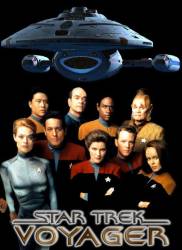Plot hole: When orbiting the planet, Seven says that for every second on Voyager, nearly a day passes on the planet and later Janeway says 3 seconds is nearly 2 days. However, throughout the episode, time seems to move much faster on the planet to fit the plot. It would take more than 6 days for 1,000 years to pass. And in a few hours (3) less than 20 years would pass (hardly enough time for the rise and fall of a civilization). For example, when they receive the transmission, they slow it down and immediately start playing it. The next scene the senior officers are listening to it and the Doctor says nearly a century has passed, but there's no reason (or indication) that they waited almost 15 hours to listen to it.
Spirit Folk - S6-E17
Plot hole: Gunfire damages the holodeck controls, and the computer announces that safety protocols are now offline. This implies that they were online before the gunfire. If they were still online before the gunfire, the bullets would not have damaged the controls.
Suggested correction: Safety protocols are meant to protect the real people in the simulation, holobullets would still cause damage to non-real people and objects.





